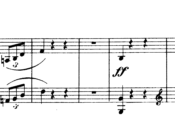Analysis
Contents
For the benefit of all pianists learning this work, we present to you a concise and easy to use analysis of Beethoven’s Piano Sonata No.27 in E Minor.
First Movement (“With liveliness and with feeling and expression throughout”)
Form: Sonata Form. E minor.
EXPOSITION:
Bars 1-25: First Subject in E minor (tonic). Very little of the first subject is in the key of the tonic. The first phrase commencing in tonic key and modulating to G major, Bars 1-5, is repeated (beginning in the key of G major and ending in B minor), Bars 5-9. The second phrase, Bars 9-17, begins in G major and ends with a pause on the dominant chord of E minor (tonic), succeeded by a four-bar phrase in that key, Bars 17-21, which is repeated, Bars 21-25, ending with full close on tonic. Excepting the slight reference to the relative major in the first subject, none of the movement is in that key.
Bars 25-55: Connecting Episode. The connecting episode commences in tonic key, Bars 25-29. A four-bar passage, Bars 29-33, in the key of C major is repeated, Bars 33-37, in A minor. A part of the same passage in B flat major is followed by a modulation to B minor upon the dominant minor ninth of which it leads into the second subject.
Bars 56-68: Second Subject in B minor. The second subject (instead of being in the relative major) is in B minor. Bars 56-61 are repeated (varied), Bars 62-67.
Bars 68-82: Coda.
DEVELOPMENT:
Bars 83-144: The development (preluded by a repetition of the three notes at the end of the second subject) commences with a reference to the first phrase of the first subject. At Bar 102 some new material is introduced, consisting of a chromatic passage which leads to a development of the second phrase of the first subject. The development ends, Bar 144, in tonic key.
RECAPITULATION:
Bars 144-168: First Subject in original key. The first subject re-appears in its original state.
Bars 168-198: Connecting Episode. The connecting episode is composed of the same material as in the exposition, transposed so as to end in tonic key.
Bars 199-211: Second Subject in E minor (tonic). The second subject is transposed into the tonic key without any alterations.
Bars 211-End: Coda. The Coda is elongated, Bar 223.
Second Movement (“Not too swiftly and conveyed in a singing manner”)
Form: Rondo Form. E Major.
FIRST PART:
Bars 1-33: First Subject in E major (tonic). The first subject begins with a four-bar section, Bars 1-5, repeated (in octaves), Bars 5-9, followed by an eight-bar section commencing in the dominant key, modulating to A major and ending in tonic key, Bars 9-17, repeated (in octaves), Bars 17-25. The first subject ends with the first section and repetition (varied), Bars 25-33.
Bars 33-41: Episode. Bars 33-41 form an episode (based upon Bars 9-11) leading to the key of the dominant.
Bars 41-70: Second Subject in B major. The second subject may be divided into two parts. The first part, Bars 41-61, is constructed almost entirely upon inverted dominant pedal point of B major. Bars 41-46 are repeated (varied), Bars 49-54. The second part, Bars 61-70, consists of a four-bar phrase in B major (Bars 61-64), repeated (Bars 65-68) in tonic key, leading with two additional bars to the second entry of the first section.
Bars 70-102: First Subject in original key. The first subject re-appears unaltered.
SECOND PART:
Bars 102-140: Development. The development commences with a passage based upon the last five notes of the first subject, leading to several repetitions of the second part of the second subject in C major, C minor, C sharp minor, and C sharp major. A passage built upon the chord of the dominant minor ninth leads to the third entry of the first subject.
THIRD PART:
Bars 140-172: First Subject in original key. The first subject re-appears unaltered.
Bars 172-181: Episode. Bars 172-181 form a passage similar to Bars 33-41 altered so as to end in tonic key.
Bars 181-230: Second Subject in E major (tonic). The second subject, which is transposed into tonic key, is extended at Bar 210 by a passage which introduces some development of Bars 3-5. At Bar 222 it ends with a passage based upon dominant harmony in canon, BArs 222-230.
Bars 230-254: First Subject in original key. The first subject is considerably varied, both the first and second sections appearing with the melody in an inner part, accompanied by a semiquaver (sixteenth note) figure in the treble, Bars 230-234, and Bars 238-246. The repetition of the first part of the first subject is omitted.
Bars 254-End: Coda. The Coda is formed on previous material, the first section of the first subject appearing at Bar 276.








